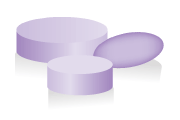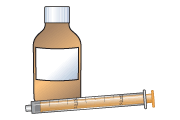Gaviscon for gastro-oesophageal reflux disease
This leaflet is for parents and carers about how to use this medicine in children. Our information may differ from that provided by the manufacturers, because their information usually relates to adults. Read this leaflet carefully. Keep it somewhere safe so that you can read it again.
Name of medicine
Gaviscon is a mixture of sodium alginate and potassium bicarbonate.
Common brands: Gaviscon, Gaviscon Advance, Gaviscon Infant
Why is it important for my child to take Gaviscon?
Gaviscon forms a layer over the surface of your child’s stomach contents. This stops the stomach contents from coming back up into the food pipe (reflux), which can be painful.
What is Gaviscon available as?
- Chewable tablets: 500 mg sodium alginate and 100 mg potassium bicarbonate; these contain aspartame
- Liquid medicine: 500 mg sodium alginate and 100 mg potassium bicarbonate per 5 mL
- Sachets of powder: each dose unit contains 225 mg sodium alginate and 87.5 mg magnesium alginate
When should I give Gaviscon
Gaviscon is usually given straight after each meal and at bedtime. You should wait at least 2 hours between doses.
How much should I give?
Your doctor will work out the amount of Gaviscon (the dose) that is right for your child. The dose will be shown on the medicine label.
It is important that you follow your doctor’s instructions about how much to give.
How should I give Gaviscon?

Tablets
- Chewable tablets should be chewed and then swallowed.

Liquid medicine
- Shake the medicine well.
- Measure out the right amount using an oral syringe or a medicine spoon. You can get these from your pharmacist. Do not use a kitchen teaspoon as it will not give the right amount.
Sachets of powder
- Open the sachet just before use. Your doctor will tell you how much of the powder to use; this will also be shown on the medicine label.
- For breast-fed babies, mix the right amount of powder with 5 mL of cooled boiled water to make a smooth paste, then mix in another 10 mL of water. Give this to your baby after the feed, using a syringe or spoon.
- For bottle-fed babies you can add the right amount of powder into the formula feed in the bottle. Shake the bottle well before feeding your baby.
- For babies weighing up to 4.5 kg (10 lb), mix the powder into at least 115 mL of formula feed.
- For babies weighing more than 4.5 kg (10 lb), mix the right amount of powder into at least 225 mL of formula feed.
When should the medicine start working?
Gaviscon should help to stop an reflux after about 30 minutes.
What if my child is sick (vomits)?
- If your child is sick less than 30 minutes after having a dose of Gaviscon, give them the same dose again.
- If your child is sick more than 30 minutes after having a dose of Gaviscon, do not give them another dose. Wait until the next normal dose.
If your child is sick again, seek advice from your family doctor, nurse, pharmacist, or hospital. They will decide what to do based on your child’s condition and the specific medicine involved.
What if I forget to give it?
If you miss a dose, you can give the missed dose up to an hour after the meal. But this should be at least 2 hours before the next dose.
What if I give too much?
You are unlikely to cause harm if you give an extra dose of Gaviscon by mistake. If you are concerned that you may have given too much, contact your doctor or local NHS services (details at end of leaflet). Have the medicine or packaging with you if you telephone for advice.
Are there any possible side effects?
We use medicines to make our children better, but sometimes they have other effects that we don’t want (side-effects).
Your child is unlikely to have any side-effects from gaviscon.
- Occasionally infants get a bit constipated (have difficulty doing a poo) as the gaviscon acts as a feed thickener.
There may sometimes be other side effects that are not listed above. If you notice anything unusual and are concerned, contact your doctor. You can report any suspected side effects to a UK safety scheme at mhra.gov.uk/yellowcard
Can other medicines be given at the same time as Gaviscon?
- You can give your child medicines that contain paracetamol or ibuprofen, unless your doctor has told you not to.
Check with your doctor or pharmacist before giving any other medicines to your child. This includes herbal and complementary medicines.
Is there anything else I need to know about this medicine?
- Gaviscon should not be used with agents that are used to thicken milk (e.g. Nestargel, Carobel) or with special infant milk preparations that are already thickened (e.g. Enfamil AR, SMA Staydown). This will make the stomach contents too thick, which will make your child feel bloated and uncomfortable.
- If your child has fever (temperature of 38°C or higher), diarrhoea, vomiting or is on a low-salt diet, check with your doctor or pharmacist before giving gaviscon, because there is a risk that your child may become dehydrated.
General advice about medicines
- Try to give medicines at about the same times each day, to help you remember.
- Only give this medicine to your child. Never give it to anyone else, even if their condition appears to be the same, as this could do harm.
- If you think someone else may have taken the medicine by accident, contact your doctor or NHS local services (details at end of leaflet) for advice.
- Make sure that the medicines you have at home have not reached the ‘use by’ date on the packaging. Give old medicines to your pharmacist to dispose of.
Where should I keep this medicine?
- Keep the medicine in a cupboard, away from heat and direct sunlight.
- It does not need to be kept in the fridge.
- Make sure that children cannot see or reach the medicine.
- Keep the medicine in the container it came in.
Who to contact for more information?
Your child’s doctor, pharmacist or health visitor will be able to give you more information about Gaviscon and other medicines used to treat gastro-oesophageal reflux.
England: NHS 111
Tel 111
www.nhs.ukScotland: NHS 24
Tel 111
www.nhs24.scotNorthern Ireland: NI Direct
Wales: NHS 111 Wales
Tel 111
www.111.wales.nhs.ukLiving With Reflux
Copyright disclaimer
Version [2]. © NPPG, RCPCH and WellChild, all rights reserved. Review by February 2017.
The primary source for the information in this leaflet is the British National Formulary for Children. For details on any other sources used for this leaflet, please contact us through our website, www.medicinesforchildren.org.uk.
We take great care to make sure that the information in this leaflet is correct and up-to-date. However, medicines can be used in different ways for different patients. It is important that you ask the advice of your doctor or pharmacist if you are not sure about something. This leaflet is about the use of these medicines in the UK, and may not apply to other countries. The Royal College of Paediatrics and Child Health (RCPCH), the Neonatal and Paediatric Pharmacists Group (NPPG), WellChild and the contributors and editors cannot be held responsible for the accuracy of information, omissions of information, or any actions that may be taken as a consequence of reading this leaflet.
